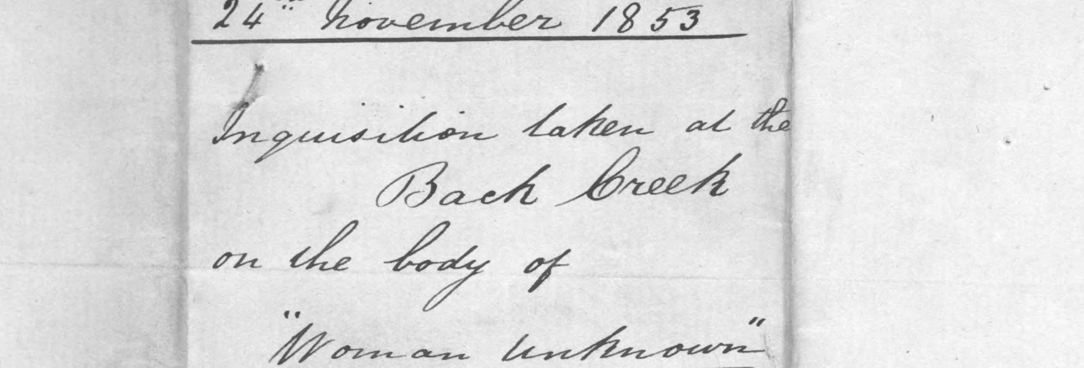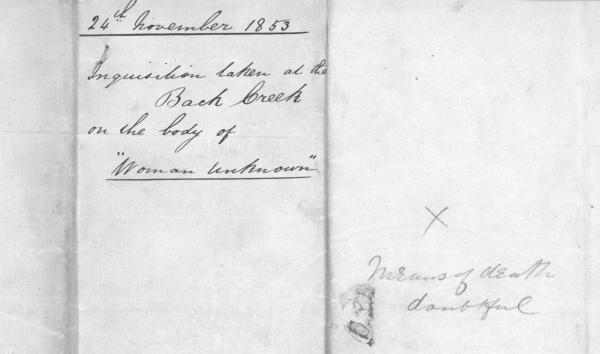
Author: Tara Oldfield
Senior Communications Advisor
Warning this article contains stories related to inquest records so may be upsetting for some readers.
She thought her luck had changed. It was 1853. She’d been living as a servant in Melbourne when a fellow servant, James Miller, asked her to come with him to make their fortune on the goldfields. He said he’d marry her. They were in Back Creek when she spoke to a young man causing Miller to fly into a jealous rage. He kicked and beat her and then took off back to Melbourne with her few possessions leaving her alone, injured, and no doubt heart broken. For a while she sat under a tree asking passers-by if they could help her to Melbourne to see a doctor.
George Wood said:
I am a Bullock driver... On the evening of Saturday, the 19th Inst. I was about to put up at the Back Creek when I saw (her) whose name I do not know sitting under a tree. She asked me to take her down to Melbourne, I asked what ailed her, she said she wanted to get to Melbourne to a Doctor, I passed on and saw her in the same place on Sunday, and again on Monday morning. On the later day I went to her, she asked for a little water… She was then taken into the House by Mrs Buckley…
Mrs Buckley had taken pity on the woman. She said:
…on Monday she asked me for a drink; I thought up to that time that she was drunk which was the reason I did not bring her in; I brought her the drink and a policeman happened to pass by at the time, I called him over, as I saw the woman was in a bad state of health. I then brought her into the house and made down a place for her to lie, and gave her something to eat and drink, she walked in with my assistance and that of a young lad of present, but was too weak to rise by herself. She told me in the presence of the policeman that she has been treated with violence by a man called James Miller, I asked her on what account, and she replied it was jealousy… I brought her in, and I advised her to put on clean linen, but she said Miller had taken a box of clothes belonging to her – She became much worse on Monday night, and on Tuesday Morning the 22nd inst I became alarmed about her, and tried to get a Doctor but could not – She died about ten o’clock on Tuesday 22nd Inst. She had no letters or papers on her person to lead to any knowledge of who she was, or any money except 3 shillings.
Though she had told both Buckley and Wood that she had been recently beaten, the medical examiner couldn’t find evidence of violence:
I am a duly qualified Medical Practitioner, living in Castlemaine, by the command of the Coroner, I made a Post Mortem Examination… there were no marks of violence at all on the body, or limbs, nor did she appear to be in an exhausted state when she died. She appeared a robust young woman, and did not seem to have had children. I saw no appearance on the body which would lead me to conclude that her death was caused by external violence - Nor from the appearance of the stomach and bowels do I think there had been any poison taken by the deceased – It is my opinion that she died rather from the effects of natural causes than from external injuries.
Perhaps she died of a broken heart?
The inquest notes that James Miller should be taken into custody until further enquiries could be made. The woman’s name at the inquest was marked “woman unknown” and on this record she remains unknown to this day.
Inquests
An inquest is a legal inquiry held to establish the exact medical cause of death of an individual when a person dies suddenly or unexpectedly for instance when a person is killed, dies whilst in prison or an asylum, drowns, was an infant ward of the state or dies under suspicious circumstances.
To search inquests in our collection you can simply type the name of your subject into the search bar on our topic page here.
But what happens when there is no name? What happens when a body was found but never identified? Search 'unknown' and you will find over 500 pages of results just like the unknown woman of Back Creek.
Inquests can tell us so much about how a person lived in the time they lived. Stories of persons unknown are no less valuable to researchers, while also revealing the difficulties faced in identifying people in a time long before formal identifications were carried, before mainstream media and photography, and of course, the internet.
New arrivals
Those who arrived in Victoria from a foreign country, without friends or family or any means of identification are amongst those to be found when searching 'unknown' in the inquests.
An inquest titled Unknown Chinese No.1 is one of a set of eight for the year 1854.
At the inquest of Unknown Chinese No. 1, Kong Ming said:
I arrived the day before yesterday in the Brig which carries Chinese Colours, I don’t know her name, or the name of the Captain, there were two hundred and fourteen sailed from Hong Kong, but twenty four died on the passage of the same sickness as the deceased…
One passenger died between Hong Kong and Singapore, the other twenty three died after wards, the agreement provided was furnished to me by the Owner of the Ship in which I came out, in which it is agreed that the passengers should be supplied with Rice, Fish and Vegetables, we got the Rice, but the Fish was rotten and we could not eat it, the water was good and plentiful, the Rice was good, the Doctor was a Chinese, he was sick himself, and did not attend the sick passengers, he gave some of them some pills, there was no quarrel on board between the Passengers and the Doctor, we were One hundred and twenty three days from Hong Kong to Port Phillip, the Fish was bad from the commencement of the voyage, we paid about Seventy dollars each for our passage, We did not eat any of the Fish, the name of the ship entered on the agreement produced is the Onyx.
(VPRS 24/ P0 unit 21, item 1854/478 Male).
This sad case made the papers at the time, read more here.
Infant unknown
Many unknown inquest files relate to babies who were as yet unnamed, unclaimed, and often murdered. In a January 1891 inquest, a baby was found to have been killed soon after birth.
I beg to report that at 2.00 pm today the dead body of a male child unknown was found floating in the Yarra near the Friendly Societies Gardens. The police removed the body to the morgue where it now lies. The body is that of an apparently fully developed child and was wrapped in a piece of flannel and some brown paper…the deceased male child unknown was wilfully murdered by some person or persons unknown.
(VPRS 24/ P0 unit 575, item 1891/46).
Georgina Rychner in an article for The Australian Women’s History Network found that between 1880 and 1914, there were 614 infants found dead in and around the city of Melbourne, with an average of 24 women charged with the crime annually. She wrote:
Reported instances of infanticide certainly outweighed the number of women charged. In the first instance it was hard for police to identify mothers, and even where the mother was identified, police and coroners faced difficulties distinguishing cases of murder from those of death by exposure. Infanticide came under the offence of murder, which carried a penalty of death. At trial jurors were unwilling or unable to convict such women for murder, often opting for the lesser charge of abandonment or concealment of birth.
The crime was largely the product of women’s inability to regulate their own reproduction. Contraception could be expensive and ineffective, leading women to resort to abortion, baby farming or infanticide as a way to rid themselves of unwanted children. Driving factors could include the inability to support a child financially, an absent or unaware father, and the shame of illegitimacy. Infanticide defendants who came before the courts were often young women who worked as domestic servants in rural areas of the state. These women travelled to Melbourne to birth their children away from the prying eyes of their communities, then resorted to smothering, strangling or drowning their infant while in the city. Often they had become pregnant by boys in their hometowns, with many defendants explaining they had been ‘seduced and abandoned.’
Read the full article here.
Human bones
Also when searching 'unknown' you will find inquests related to the discovery of bones, often believed to be the remains of Aboriginal people.
In an 1885 inquest, the discovery of human bones is described by police:
I beg to report that John Barr boundary rider for Mr Brown of Green Hills estate near Melton reported at the Police Station yesterday afternoon that two men who were digging rabbit burrows on the edge at Dry Creek unearthed a skeleton. I at once went to the place - the men stated that it (the skeleton) was in a sitting position two feet below the surface...
(VPRS 24/ P0 unit 484, item 1885/755).
In this case the bones were thought to be from an Aboriginal person buried approximately 40 years prior. The bones had been taken to the police station and it's unclear from the inquest if they were later returned to the site they were found.
Aboriginal Victoria provides information on Aboriginal burials here.
Insight for researchers
The stories of the unknown provide valuable insight into how people lived, died and the difficulties of identification. It is sad to think that there would have been people who loved and knew them who never got answers as to what happened to them or a chance to identify them putting a name to these stories, and records.
Thank you to the volunteers who transcribed so many unknown inquests. I’ve only shared a few here.
Explore inquests and other coronial records here.

